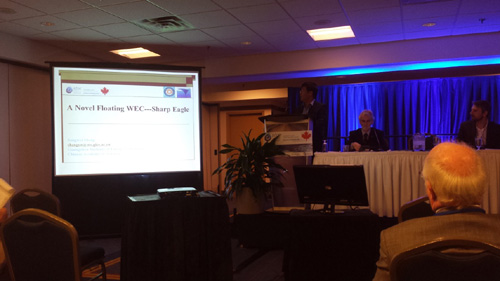GIEC participated in ICOE2014
The 5th International Conference on Ocean Energy (ICOE) was held on November 4-6, 2014 in the seaport city Halifax, Nova Scotia, Canada. ICOE was first established in 2006 and is now held every two years. It has grown to almost 1000 participants from almost 40 countries, had a significant tradeshow in 2012, and is now recognized as the world’s pre-eminent industry-development event.
There were more than 600 people from research institutes, universities, enterprises and non-profit organizations of over 25 countries and regions in the world attending ICOE2014. They discussed a lot of topics, such as the market of ocean energy equipment, the path of ocean energy industrialization, the government’s strategic leadership, international cooperation, the current technology situation of ocean energy, the next generation of ocean energy technology, etc. Songwei Sheng and Kunlin Wang were invited to attend the conference.
Dr Sheng made a presentation entitled “A Floating Novel Wave Energy Converter - Sharp Eagle” in the conference session. He introduced the new wave energy converter with full intellectual property rights of Guangzhou institute of energy conversion (GIEC). Dr Sheng’s speech causes extensive concern of the international counterparts.
Sharp Eagle has high conversion efficiency, high reliability, and is easy to deploy and maintain. PCT retrieval report pointed out that Sharp Eagle has the characters of novelty, creativity and industrial practicality. Its intellectual property rights were owned by GIEC. In recent years GIEC has focused on researching and developing Sharp Eagle. After 10 kW Sharp Eagle achieved long-term stable operation, the Marine Energy Fund of China supported GIEC to further develop 100 kW Sharp Eagle in 2013. Now the converter is in building process. It will be put into the sea for test in early 2015.
During ICOE 2014, GIEC delegates were invited to discuss with French delegates and Canada delegates, including cooperation intentions and technology exchange. GIEC delegates also visited Canada ocean energy research center and the world's second largest tidal power station - Canada Annapolis tidal power station.

